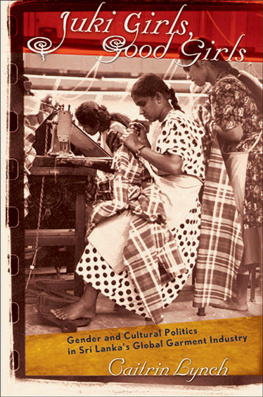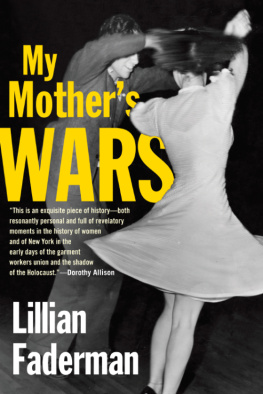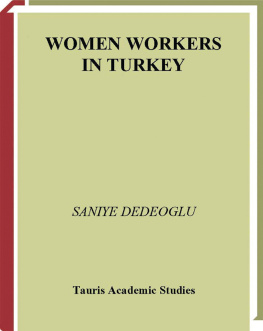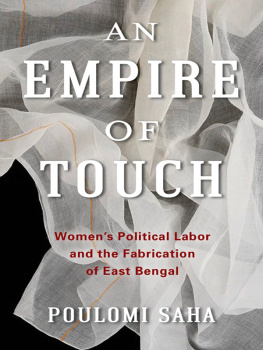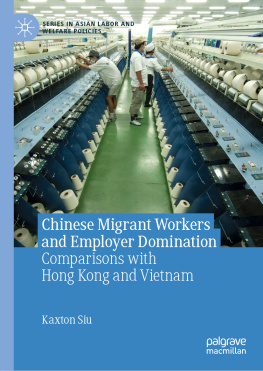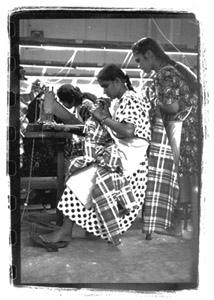Juki Girls, Good Girls
Gender and Cultural Politics in Sri Lankas
Global Garment Industry
CAITRIN LYNCH
ILR PRESS an imprint of CORNELL UNIVERSITY PRESS Ithaca and London
To Nick, Cormac, and Nicola,
and to the workers at Shirtex and Serendib
CONTENTS
ACKNOWLEDGMENTS
I have accrued many debts in the years that I have been working on this book. The first person to direct me on this long road was Steven Kemper at Bates College, whose course on South Asia was my introduction to the region and the discipline. It is thanks to Steve that I became interested in anthropology and Sri Lanka... and I never turned back.
This project was made possible by the generosity and kindness of many people in Sri Lanka. Owing to concerns about confidentiality, I employ pseudonyms for the factories and all people connected to them. I regret that I cannot thank individuals by name, but special thanks are due the many workers and managers at Shirtex and Serendib whom I describe in this book and particularly the workers I have named Rohini, Mala, and Geeta, whose essays are printed here. I am deeply grateful to Tissa Gunasekera and Asanka Perera (alas, pseudonyms) for allowing me into their factories and providing me with better access to these workplaces than I had anticipated. I also thank the many other investors I interviewed in Colombo, as well as the many managers and investors who welcomed me into their factories in Colombo, the Katunayake Free Trade Zone, and in villages throughout the country. At the Board of Investment, I thank H. B. Masinghe, N. N. Kumaratunga, and Mrs. Pestonjee. Thanks are also due Susil Sirivardana, Sirisena Cooray, Anthony Fernando, Dayan Jayatilleka, and others for illuminating discussions about President Premadasa and the 200 Garment Factories Program.
I am grateful to numerous scholars at the University of Peradeniya and the International Centre for Ethnic Studies (ICES) in Kandy, the two institutions with which I was affiliated during my field research. These scholars include K. M. de Silva, R. A. L. H. Gunawardana, Ashley Halpe, Sirima Kiribamune, Udaya Meddagama, Walter Perera, Gerald Pieris, Sisira Pinnawela, Sudarshen Seneviratne, Tudor Silva, and Carmen Wickremagamage. Scholars in Colombo who provided help include Sunil Bastian, Janaka Biyanwila, Radhika Coomaraswamy, Malathi de Alwis, S. T. Hettige, Tissa Jayatilaka, Kumari Jayawardena, Pradeep Jeganathan, and Darini Rajasingham-Senanayake. I should also mark my appreciation for the valuable comments I received from audiences at presentations of elements of my field research at ICES Colombo, ICES Kandy, the Sri Lankan Federation of University Women (Kandy Branch), and the British Council in Kandy.
Athulya Meddagama was my primary research assistant. Her enthusiasm and kind spirit were always appreciated and facilitated warm relations with factory workers who would ask after her when she wasnt around. Her translation and transcription skills were invaluable. I also thank the numerous other people I employed as research assistants at various stages of the field research: S. A. P. Benedict, Rosemary Chunchie, Mevna de Silva, Mrs. Nandana Galpaya, Mihiri Herath, Michael Joachim, Iyanka Karunaratne, Indu Meddagama, Rizmia Naushad, Kanchana Ratnasara, Gayatri Samarakoon, and Udeni Samarakoon. In the final hour of book preparation, I recruited Nilam Hamead, Upali Lionel, and Sriyani Mallika Ranawana for help in Sri Lanka. Special thanks to Rosemary Chunchie, Yolanda Foster, Susila and Gamini Gunawardane, Cricket Keating, and Saku Richardson for their friendship and assistance during field-work. Thanks also to the ISLE Program for providing me with a home for part of my stay, as well as to Bertram Tittawala for being a great landlord for the other part and for helping me locate Hansard Reports and other documents on the 200 Garment Factories Program. I also thank the staff at the Sarvodaya office in Udakande for allowing me to use their offices for occasional interviews.
My debts in the United States have been incurred at several institutions. This project began as a Ph.D. dissertation at the University of Chicago. My adviser, Arjun Appadurai, saw it through all the dissertation stages; and his influence has carried on through to this book, which represents a substantial revision of that material. My other three committee members were invaluable: Leora Auslander provided critical assistance throughout the years; Nadia Abu El-Haj was a fabulous late arrival who provided a new perspective that challenged me in productive directions; and the humor and insight of the late Bernard Cohn will never be forgotten. Other important assistance at Chicago came from Carol A. Breckenridge, Sheldon Pollock, Susanne Rudolph, and David Scott.
At Johns Hopkins University, my deepest thanks are owed to Veena Das for inviting me to join the Program for the Study of Women, Gender, and Sexuality as a Mellon Postdoctoral Fellow. For critical comments on earlier versions of chapters, I thank Veena as well as Aaron Goodfellow, Naveeda Khan, Ruby Lal, Gyan Pandey, Jennifer Robertson, Deniz Ykseker, and audiences at seminars where I presented my work.
Administrators, students, and colleagues at Olin College of Engineering have provided me with support that allowed me to finish this book. In particular, I thank Holly Bennett, Helen Donis-Keller, Rob Martello, Mike Moody, and Lynn Andrea Stein for help during the last stage of manuscript preparation. Lynn and Rob both read the entire manuscript at different critical junctures. Lynn, my work buddy during the summer of 2005, put her brilliance to work identifying problems and solutions. Rob, the smartest and funniest midnight email buddy one could want, sacrificed his own writing time for a detailed read of my manuscript. Students in my classes at Olin College and Wellesley College read most or all of the manuscript in 2005 and 2006. I thank them for being a test audience: I wrote this book with undergraduates in mind, and these students helped me identify what was needed. Several Olin students provided critical assistance: Sutee Dee provided valuable editing help; Sylvia Schwartz helped at the very end; and this book simply wouldnt have been completed without the humor, patience, insightful comments and queries, and hard work of Jerzy Wieczorek, who was my research assistant during the summer of 2005.
Other friends and colleagues who read versions of my work or provided other help that was needed for it to come together include Marc Boglioli, Cindy Caron, Joslyn Cassady, Jane Collins, Elizabeth Emma Ferry, Michele Gamburd, Rosanna Hertz, Alan Keenan, Steve Kemper, Jeanne Marecek, Dennis McGilvray, Janet McIntosh, Sonya Michel, Diane Mines, John Rogers, Kate Schechter, H. L. Seneviratne, Ajit Serasundera, Deborah Winslow, and Michael Woost. I am also grateful to discussants and audiences at various venues where I presented this work over the years. Seamus Walsh and Dennis McGilvray kindly gave me permission to publish their photographs. Critical assistance on book chapters in the summer of 2005 came from Eliza Kent and especially from Sarah Lamb, whose close reading of many chapters was just what I needed.
Next page
